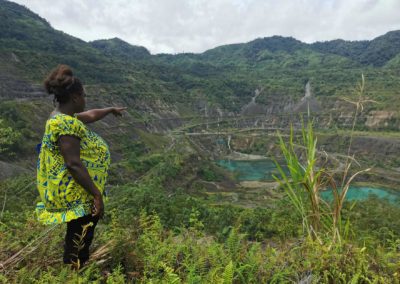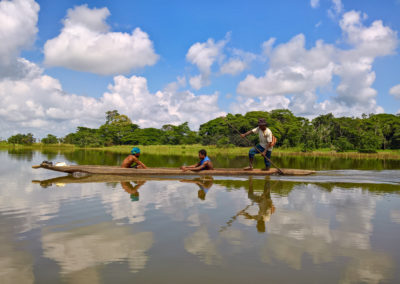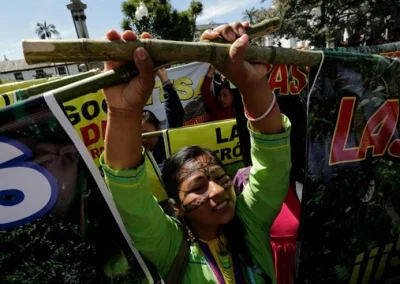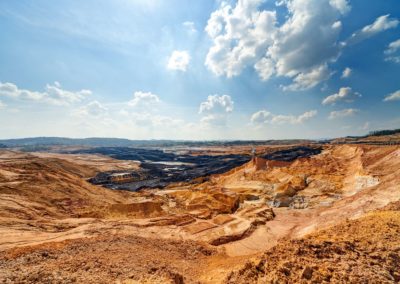COPPER COMMUNIQUÉ:
IN THE RACE TO NET ZERO ‘COPPER IS THE NEW OIL’ - BUT AT WHAT COST?14th December 2021
By Claire Burgess, University of Tasmania, PhD Candidate in Geography (Aid/Watch Committee Member) and Liz Downes, Rainforest Information Centre. Supported by Aid/Watch
We would like to acknowledge and thank the on the ground campaigners particularly those within the Yes to Life No to Mining global network, whose research has been integral to this communiqué.
View Global Lithium Communiqué
COPPER COMMUNIQUÉ: CONTENTS
COUNTER NARRATIVES & ALTERNATIVES
CONCLUSION, OBJECTIVES AND RECOMMENDATIONS
CASE STUDIES
View case studies from Australia, Democratic Republic of Congo, Zambia, Ecuador, Phillipines and Papua New Guinea
What is driving the copper mining boom?
New green economies are responding to the climate crisis by promoting policies that advance a transition from fossil fuels to raw material dependent ‘clean’ energy technologies. This is accelerating a global mining boom. There are emerging concerns about the socio-ecological implications of the intensification of destructive mining activities in the name of climate action. Green growth proponents are seeking to advance mining companies’ operations into new areas for metals extraction. This is already impacting on countries of the global south and Indigenous lands, where billions of tonnes of reserves for critical minerals are “yet to be discovered”.
Copper, according to Goldman Sachs, ‘is the new oil’ deemed most important for decarbonisation. Demand for the metal, used in large quantities in wind, solar, electric vehicles and energy infrastructure, is set to increase by 600% by 2030. Wealthy nations and companies associated with copper related products are by proportion the highest consumers of the metal, and so are generating most of the demand.
Can copper mining be green?
The planetary footprint of ‘clean energy’ technologies has been largely dismissed by green growth proponents. Aside from relying on energy-intensive operations, copper mining has also been often linked to human rights abuses, ecological destruction, pollution, environmental conflict and the exploitation of less powerful nations by foreign transnational companies and associated stakeholders.
This has created extractive enclaves that provide little benefit to local economies while facilitating the unsustainable production and consumption patterns which are occurring largely in wealthy nations. The sheer destructive nature of copper mining requires the disruption of massive quantities of earth destroying the living components of ecosystems and their material foundation – rendering the capacity for “sustainable” mining impossible. Within this context, Australia is pegged by industry experts and being propelled by their ally the United States to play a key role in securing access to key transition minerals.
Australian 'green' copper context
Australia holds 24 per cent share of global copper production and is in a strong position to increase GDP by 1% purely from mining transition minerals. Several of the largest copper mining companies in the world are Australian-owned and operated, such as RioTinto and BHP Group LImited with exploration projects and productive mines domestically and overseas. Newcrest, Sandfire Resources and OZ Minerals, are also significant. These companies saw large rises in share price through 2021. Industry analysts predict a green renewables super cycle, with capital switching from oil-related assets to copper-related assets.
Despite the Australian Government’s continued approval of new fossil fuel projects, there is a rapid increase in mining of transition minerals by Australian companies, both domestically and overseas. This is largely supported by the Federal government, the dominant media conglomerates, mining industry bodies, and “clean” energy proponents. The Department of Foreign Affairs and Trade (2021) talks of ‘emerging bilateral links in green energy and connectivity’. Additional key players driving this market include allied governments (eg. UK, U.S) who seek to secure access to critical minerals, international corporations and powerful transnational financial asset managers.
As Australian mining companies expand their operations, governments are increasingly focusing on producing ‘investor friendly’ regulations and jurisdictions. Trends emerging with the global rush for ‘clean energy’ minerals include collaborations across supply chains between industries and governments to ensure competitive market access to land and natural resources for critical minerals through “community engagement” for social licence.
Despite the efforts to “green” copper, the industry has largely remained the same with regards to generating severe impacts to drinking water aquifers, contamination of farmland, contamination of fish and wildlife and their habitat, and risks to public health
Australia’s copper footprint
Map above: Australian copper footprint: domestic and overseas
The largest copper mines that are Australian owned are spread across South Australia (Olympic Dam, Prominent Hill), New South Wales (Cadia Mine), Western Australia (Degrussa mine), and Queensland (Ernest Henry – Evolution sale to be finalised 2022). The Minerals Council states that mining and the mining equipment, technology and services (METS) sector account for approximately 15 percent of Australia’s gross domestic product.
Globally, Australia’s biggest copper production is in the Atacama region of Chile, where the world’s biggest copper mine (Escondida – BHP) is located. Australia also has mines and is exploring in Peru and Ecuador, which like Chile are part of the Andean Copper Belt. Other hotspots for copper include the US, Canada, and the Kalahari and Zambian copper belts (Botswana, Namibia, Zambia and Democratic Republic of Congo). Per country, the biggest imprint of Australian companies for copper exploration is currently Ecuador, where Australian companies own around 540,000 hectares of land.
Despite the efforts to “green” copper, the industry has largely remained the same with regards to generating severe impacts to drinking water aquifers, contamination of farmland, contamination of fish and wildlife and their habitat, and risks to public health.
Projects of concern in terms of human rights and/or environmental impact and risks include:
-
- Rio Tinto and BHP’s Resolution Copper project in Arizona
- Rio Tinto’s Oyu Tolgoi project in Mongolia
- Newcrest’s Wafi Golpu project in PNG
- Oceana Gold’s Dipidio project in the Philippines
- Lake Torrens, Salt Lakes, sacred sites in Australia
COUNTER NARRATIVES AND ALTERNATIVES
Image above: “Water is Life” national march against mining, Ecuador, 2018. Photo: Carlos Zorrilla
The dominant narrative about humanity’s relationship with the natural world that we are deeply intertwined with and dependent upon needs to be reimagined. This should start with challenging the assumptions often made in settler – colonial cultures such as Australia. Movements resisting the expansion of extractivism for ‘critical minerals’, especially on indigenous lands and smallholder farmers, fisherfolk across the globe are frequently centred around messaging which refers to the value of land, livelihoods and water over the minerals being extracted.
-
- In Australia, the Regenerative Songlines Australia aims to weave together a continent-wide network that connects regenerative practice and programmes, led by First Nations peoples and inclusive of all Australians.
- In Papua New Guinea, a collective of tribal groups have formalised the Supreme Sukundimi Declaration which enshrines cultural obligations to the guardians of the land, ancestors and future generations. This outlines ‘no go’ zones for extractive development and commitments to protect and celebrate life on the Sepik.
- In the Intag region of Ecuador, the Sanctuary of Life initiative has been created with the support of local governments to help communities resist the onslaught of mining by employing local people in ecotourism projects, attracting scientists to research the region’s biodiversity and advancing legal arguments around the rights of nature.
- “Water is Life” movements are growing in several places around the world, promoting water as being more valuable than metal commodities due to its sacredness and importance for life, livelihoods and ecosystems.
For more examples, view the Yes to Life, No to Mining – emblematic alternatives.
CONCLUSION, OBJECTIVES AND RECOMMENDATIONS
CONCLUSION
Wealthy nations’ demand for a ‘green growth’ approach to climate action is driving an increased demand for copper and Australian mining companies are seeking to extract these minerals with the support of allied countries (US, UK) seeking to secure ‘critical’ mineral supply chains. Australia’s mining industry players are facilitated by investor-friendly policies determined through strategic trade agreements with less powerful countries that have mineral reserves. Australian companies’ credentials and pro-mining policies are increasingly being marketed as ‘essential’ for a ‘clean and green’ future. However, the reality on the ground is often far from the image that is presented.
As the Way Forward report outlines, Aboriginal Cultural Heritage legislation across Australia is not fit for purpose and allows minister discretion for industry to obtain approval for destroying sacred sites. Furthermore, there is a culture within the Australian mining industry of misleading communities, both domestically and overseas. Government regulations currently fail to protect the ‘right to say no’ which is implied in Free Prior Informed Consent (FPIC) described in the United Nations Declaration on the Rights of Indigenous Peoples. Developing countries are often locked into short-term boom and bust industrial arrangements that leave in their wake legacies of human rights violations and ecological destruction.
The numerous case studies of copper mining demonstrate evidence of impacts upon local ecosystems including water depletion, polluted waterways, deforestation, biodiversity loss and contaminated soils. Human rights related implications include militarised violence, increased threats toward environmental defenders, forced displacements, negative health impacts and risk to life and livelihoods.
OBJECTIVES
1. To endorse, amplify and advocate A Way Forward. The report calls for an overhaul of Australia’s cultural heritage protection regulations and a review of the Native Title Act 1993 to address power imbalances in negotiations based on free, prior and informed consent.
2. To endorse, amplify and advocate for Red Lines for Extractivism. A statement written by a global coalition of frontline groups for the COP26 People’s Summit 2021.
3. To endorse, amplify and advocate for the creation of a ‘circular society’. This has been presented in a War on Want, London Mining Network and Yes to Life No to Mining joint report A Material Transition (2021), calling for high consuming countries to take responsibility for their over-reliance on finite resources. Recognising that a fundamental change to Global North economies and lifestyles is the only sustainable option for reducing the demand for critical minerals.
4. To build networks of solidarity centred in justice. This must be built across Australia and internationally in collaboration with environmental and human rights defenders, Indigenous peoples, fisherfolk, campesino groups and frontline communities. Where their value-based systems centred in reciprocity and custodianship are respected in their resistance against mining and other extractive projects in their lands, mountains, rivers and waters.
5. To stand with communities in their ‘Right to Say No’. This must include the right to self-determination, collective rights, and the right to self-govern based on principles of sustainability and care for humans as well as non-human living forms.
RECOMMENDATIONS
1. Australian companies must be held responsible for their domestic and overseas impacts on people and the environment. This requires the Australian government to improve oversight and independent monitoring of company activities to ensure diligence with regard to legal obligations in host countries and internationally.
2. Communities harmed by overseas Australian investments, operations or activities must have access to justice within Australia. This should include the introduction of mandatory human rights and environmental due diligence obligations for large Australian companies especially those operating in high-risk locations and sectors.
3. Australian climate policies must be centred on justice and equity. This should include exposing and holding to account all misleading branding of “clean” energy and “renewable” technologies. Justice and equity must be centred across all value and supply chains of the transition to prevent further global intensification of destructive extractivist practices, particularly in vulnerable ecological and cultural regions.






